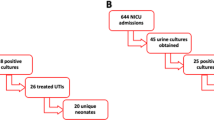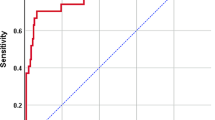Abstract
Background and objectives
Data on urinary tract infections (UTIs) in very preterm neonates (VPTNs) are scarce. We aimed to (i) describe the characteristics of UTIs in VPTNs and (ii) compare the diagnostic practices of neonatal clinicians to established pediatric guidelines.
Methods
All VPTNs (<29 weeks GA) with a suspected UTI at the CHU Sainte-Justine neonatal intensive care unit from January 1, 2014, and December 31, 2019, were included and divided into two definition categories: Possible UTI, and Definite UTI.
Results
Most episodes were Possible UTI (87%). Symptoms of UTIs and pathogens varied based on the definition category. A positive urinalysis was obtained in 25%. Possible UTI episodes grew 2 organisms in 62% of cases and <50,000 CFU/mL in 62% of cases.
Conclusion
Characteristics of UTIs in VPTNs vary based on the definition category and case definitions used by clinicians differ from that of established pediatric guidelines.
This is a preview of subscription content, access via your institution
Access options
Subscribe to this journal
Receive 12 print issues and online access
$259.00 per year
only $21.58 per issue
Buy this article
- Purchase on Springer Link
- Instant access to full article PDF
Prices may be subject to local taxes which are calculated during checkout

Similar content being viewed by others
Data availability
The datasets generated during and/or analyzed during the current study are not publicly available to preserve the privacy of patient data but are available from the corresponding author on reasonable request.
References
Chang SL, Shortliffe LD. Pediatric urinary tract infections. Pediatr Clin North Am. 2006;53:379–400.
Shaikh N, Morone NE, Bost JE, Farrell MH. Prevalence of urinary tract infection in childhood: a meta-analysis. Pediatr Infect Dis J. 2008;27:302–8.
Bhat RG, Katy TA, Place FC. Pediatric urinary tract infections. Emerg Med Clin North Am. 2011;29:637–53.
Millner R, Becknell B. Urinary Tract Infections. Pediatr Clin North Am. 2019;66:1–13.
Finnell SM, Carroll AE, Downs SM. Technical report-Diagnosis and management of an initial UTI in febrile infants and young children. Pediatrics. 2011;128:e749–70.
Robinson JL, Finlay JC, Lang ME, Bortolussi R. Urinary tract infections in infants and children: Diagnosis and management. Paediatr Child Health. 2014;19:315–25.
Pediatrics AAo. Urinary Tract Infection: Clinical Practice Guideline for the Diagnosis and Management of the Initial UTI in Febrile Infants and Children 2 to 24 Months. Pediatrics. 2011;128:595.
Stein R, Dogan HS, Hoebeke P, Kocvara R, Nijman RJ, Radmayr C, et al. Urinary tract infections in children: EAU/ESPU guidelines. Eur Urol. 2015;67:546–58.
Mohseny AB, van Velze V, Steggerda SJ, Smits-Wintjens V, Bekker V, Lopriore E. Late-onset sepsis due to urinary tract infection in very preterm neonates is not uncommon. Eur J Pediatrics. 2018;177:33–8.
Tamim MM, Alesseh H, Aziz H. Analysis of the efficacy of urine culture as part of sepsis evaluation in the premature infant. Pediatr Infect Dis J. 2003;22:805–8.
Foglia EE, Lorch SA. Clinical Predictors of Urinary Tract Infection in the Neonatal Intensive Care Unit. J Neonatal Perinat Med. 2012;5:327–33.
Biyikli NK, Alpay H, Ozek E, Akman I, Bilgen H. Neonatal urinary tract infections: analysis of the patients and recurrences. Pediatrics Int. 2004;46:21–5.
Asghar AM, Leong T, Cooper CS, Arlen AM. Hospital-acquired Urinary Tract Infections in Neonatal ICU Patients: Is Voiding Cystourethrogram Necessary? Urology. 2017;105:163–6.
Kanellopoulos TA, Vassilakos PJ, Kantzis M, Ellina A, Kolonitsiou F, Papanastasiou DA. Low bacterial count urinary tract infections in infants and young children. Eur J Pediatrics. 2005;164:355–61.
Swerkersson S, Jodal U, Ahren C, Sixt R, Stokland E, Hansson S. Urinary tract infection in infants: the significance of low bacterial count. Pediatr Nephrol. 2016;31:239–45.
Bauer S, Eliakim A, Pomeranz A, Regev R, Litmanovits I, Arnon S, et al. Urinary tract infection in very low birth weight preterm infants. Pediatr Infect Dis J. 2003;22:426–30.
Vachharajani A, Vricella GJ, Najaf T, Coplen DE. Prevalence of upper urinary tract anomalies in hospitalized premature infants with urinary tract infection. J Perinatol. 2015;35:362–6.
Walawender L, Hains DS, Schwaderer AL. Diagnosis and imaging of neonatal UTIs. Pediatrics Neonatol. 2020;61:195–200.
Lai A, Rove KO, Amin S, Vricella GJ, Coplen DE. Diagnosis and Management of Urinary Tract Infections in Premature and Term Infants. NeoReviews. 2018;19:e337–e48.
Drumm CM, Siddiqui JN, Desale S, Ramasethu J. Urinary tract infection is common in VLBW infants. J Perinatol. 2019;39:80–5.
Network CN. The Canadian Neonatal Network Abstractor’s Manual. 2011. Available from: http://www.canadianneonatalnetwork.org/Portal/LinkClick.aspx?fileticket=U4anCYsSN20%3D&tabid=69.
Gauthier M, Chevalier I, Sterescu A, Bergeron S, Brunet S, Taddeo D. Treatment of urinary tract infections among febrile young children with daily intravenous antibiotic therapy at a day treatment center. Pediatrics. 2004;114:e469–76.
Cernada M, Brugada M, Golombek S, Vento M. Ventilator-associated pneumonia in neonatal patients: an update. Neonatology. 2014;105:98–107.
Ergenekon E, Çataltepe S. Ventilator-associated pneumonia in the NICU: time to boost diagnostics? Pediatr Res. 2020;87:1143–4.
Bell MJ, Ternberg JL, Feigin RD, Keating JP, Marshall R, Barton L, et al. Neonatal necrotizing enterocolitis. Therapeutic decisions based upon clinical staging. Ann Surg. 1978;187:1–7.
Heijting IE, Antonius TAJ, Tostmann A, de Boode WP, Hogeveen M, Hopman J, et al. Sustainable neonatal CLABSI surveillance: consensus towards new criteria in the Netherlands. Antimicrob Resist Infect Control. 2021;10:31.
Bekhof J, Reitsma JB, Kok JH, Van Straaten IH. Clinical signs to identify late-onset sepsis in preterm infants. Eur J Pediatrics. 2013;172:501–8.
Sullivan BA, Nagraj VP, Berry KL, Fleiss N, Rambhia A, Kumar R, et al. Clinical and vital sign changes associated with late-onset sepsis in very low birth weight infants at 3 NICUs. J Neonatal Perinat Med. 2021;14:553–61.
Mithal LB, Yogev R, Palac HL, Kaminsky D, Gur I, Mestan KK. Vital signs analysis algorithm detects inflammatory response in premature infants with late onset sepsis and necrotizing enterocolitis. Early Hum Dev. 2018;117:83–9.
Sullivan BA, Fairchild KD. Vital signs as physiomarkers of neonatal sepsis. Pediatr Res. 2022;91:273–82.
Araujo da Silva AR, Marques AF, Biscaia di Biase C, Zingg W, Dramowski A, Sharland M. Interventions to prevent urinary catheter-associated infections in children and neonates: a systematic review. J Pediatr Urol. 2018;14:556.e1–e9.
Goldberg L, Borovitz Y, Sokolover N, Lebel A, Davidovits M. Long-term follow-up of premature infants with urinary tract infection. Eur J Pediatrics. 2021;180:3059–66.
Gorski DP, Bauer AS, Menda NS, Harer MW. Treatment of positive urine cultures in the neonatal intensive care unit: a guideline to reduce antibiotic utilization. J Perinatol. 2021;41:1474–9.
Ruangkit C, Satpute A, Vogt BA, Hoyen C, Viswanathan S. Incidence and risk factors of urinary tract infection in very low birth weight infants. J Neonatal Perinat Med. 2016;9:83–90.
Tamadonfar KO, Omattage NS, Spaulding CN, Hultgren SJ. Reaching the End of the Line: Urinary Tract Infections. Microbiol Spectrum. 2019;7:1–16.
Gatt D, Lendner I, Ben-Shimol S. Catheter-obtained, Enterococcus and Proteus positive urine cultures may represent mostly contamination or asymptomatic bacteriuria in infants <90 days. Infect Dis. 2021;53:332–9.
Pantell RH, Roberts KB, Adams WG, Dreyer BP, Kuppermann N, O’Leary ST, et al. Clinical Practice Guideline: Evaluation and Management of Well-Appearing Febrile Infants 8 to 60 Days Old. Pediatrics. 2021;148:1–38.
Tzimenatos L, Mahajan P, Dayan PS, Vitale M, Linakis JG, Blumberg S, et al. Accuracy of the Urinalysis for Urinary Tract Infections in Febrile Infants 60 Days and Younger. Pediatrics. 2018;141:1–8.
Shaikh N, Shope TR, Hoberman A, Vigliotti A, Kurs-Lasky M, Martin JM. Association Between Uropathogen and Pyuria. Pediatrics. 2016;138:1–5.
Schroeder AR, Chang PW, Shen MW, Biondi EA, Greenhow TL. Diagnostic accuracy of the urinalysis for urinary tract infection in infants <3 months of age. Pediatrics. 2015;135:965–71.
Hays T, Thompson MV, Bateman DA, Sahni R, Tolia VN, Clark RH, et al. The Prevalence and Clinical Significance of Congenital Anomalies of the Kidney and Urinary Tract in Preterm Infants. JAMA Netw Open. 2022;5:e2231626.
Nowell L, Moran C, Smith PB, Seed P, Alexander BD, Cotten CM, et al. Prevalence of renal anomalies after urinary tract infections in hospitalized infants less than 2 months of age. J Perinatol. 2010;30:281–5.
Hoberman A, Charron M, Hickey RW, Baskin M, Kearney DH, Wald ER. Imaging studies after a first febrile urinary tract infection in young children. N Engl J Med. 2003;348:195–202.
Mattoo TK, Shaikh N, Nelson CP. Contemporary Management of Urinary Tract Infection in Children. Pediatrics. 2021;147:e2020012138.
National Institute for Health and Care Excellence: Guidelines. Urinary tract infection in under 16s: diagnosis and management. London: National Institute for Health and Care Excellence (NICE); 2018.
Kaufman J, Temple-Smith M, Sanci L. Urinary tract infections in children: an overview of diagnosis and management. BMJ Paediatr Open. 2019;3:e000487.
Perlsteyn M, Stritzke A. The catch with urine: A justification for ultrasound-guided suprapubic tap in the NICU. Paediatrics Child Health. 2021;26:456–7.
Richardson DK, Corcoran JD, Escobar GJ, Lee SK. SNAP-II and SNAPPE-II: Simplified newborn illness severity and mortality risk scores. J Pediatrics. 2001;138:92–100.
Bancalari E, Jain D. Bronchopulmonary Dysplasia. In: Neonatal-Perinatal Medicine: Disease of the Fetus and Infant. Philadelphia: Elsevier; 2020. 1256–69.
Author information
Authors and Affiliations
Contributions
Drs Assil Abda, Julie Blackburn, Christian Lachance, Luc Panetta, and Melanie Sicard contributed to the study design. Dr. Assil Abda designed the data collection instruments, collected data, carried out analyses, drafted the initial manuscript, and critically reviewed and revised the manuscript. Dr. Luc Panetta collected data and critically reviewed and revised the manuscript. Dr. Melanie Sicard conducted analyses, created the initial data tables, and critically reviewed and revised the manuscript. Drs Philippe Ovetchkine, Julie Blackburn, and Isabelle Chevalier critically reviewed and revised the manuscript. Dr. Christian Lachance conceptualized the study, supervised data collection, and critically reviewed and revised the manuscript. All authors approved the final manuscript and agreed to be accountable for all aspects of the work.
Corresponding author
Ethics declarations
Competing interests
The authors declare no competing interests.
Additional information
Publisher’s note Springer Nature remains neutral with regard to jurisdictional claims in published maps and institutional affiliations.
Supplementary information
41372_2024_1951_MOESM1_ESM.docx
Supplementary Table 1. Microbiologic characteristics of the four episodes with concomitant bacteremia with the same pathogen
Rights and permissions
Springer Nature or its licensor (e.g. a society or other partner) holds exclusive rights to this article under a publishing agreement with the author(s) or other rightsholder(s); author self-archiving of the accepted manuscript version of this article is solely governed by the terms of such publishing agreement and applicable law.
About this article
Cite this article
Abda, A., Panetta, L., Blackburn, J. et al. Urinary tract infections in very premature neonates: the definition dilemma. J Perinatol (2024). https://doi.org/10.1038/s41372-024-01951-1
Received:
Revised:
Accepted:
Published:
DOI: https://doi.org/10.1038/s41372-024-01951-1



